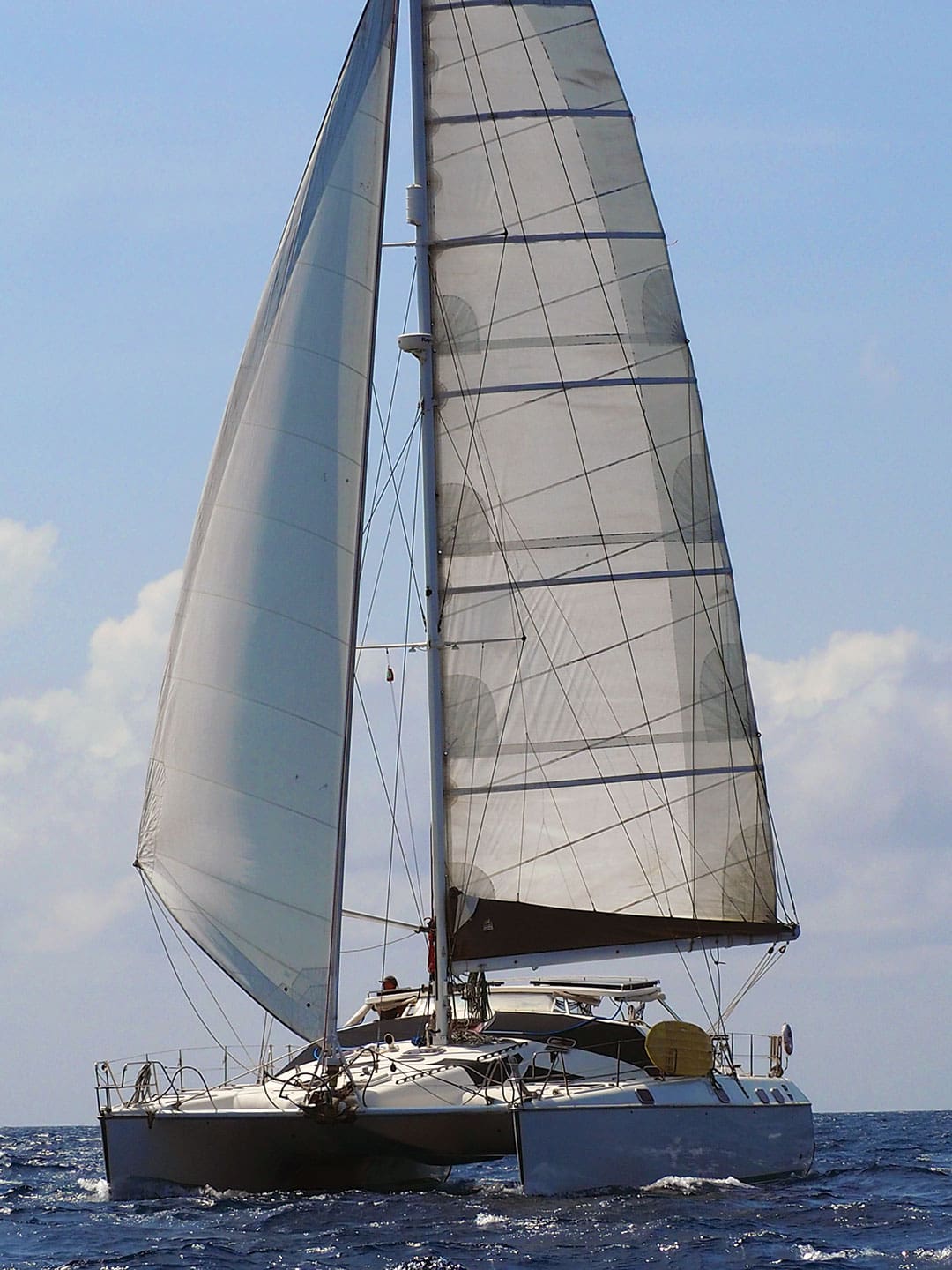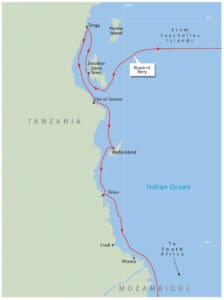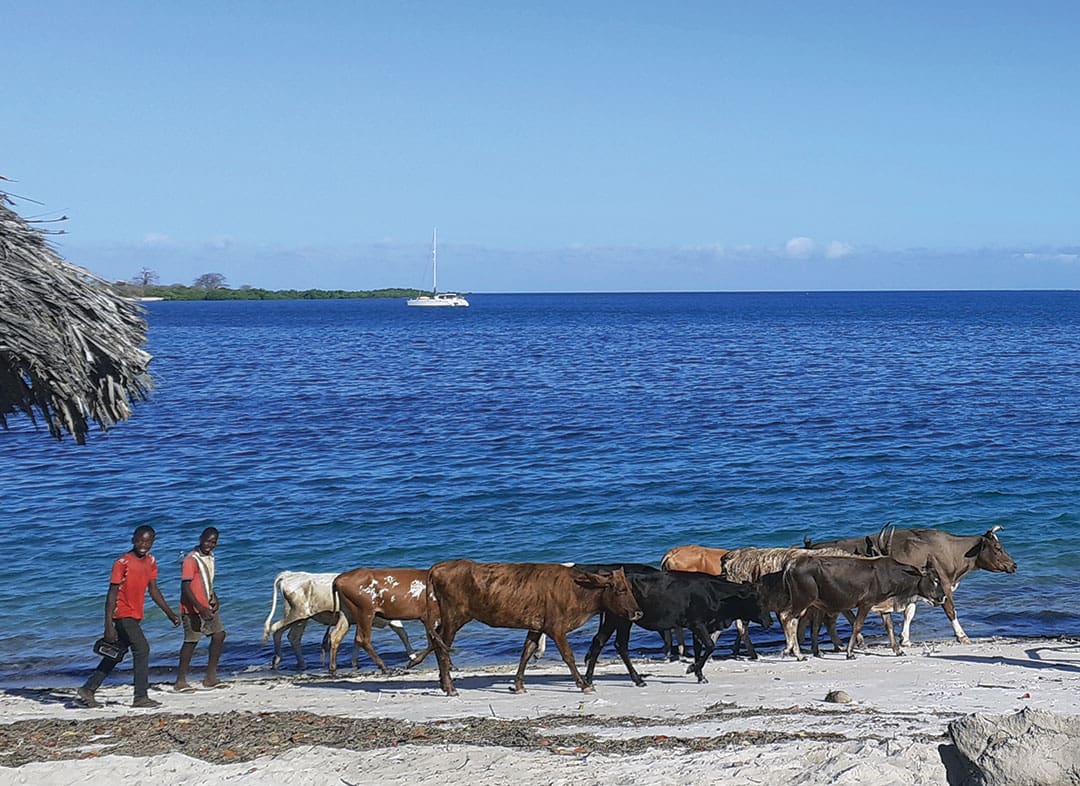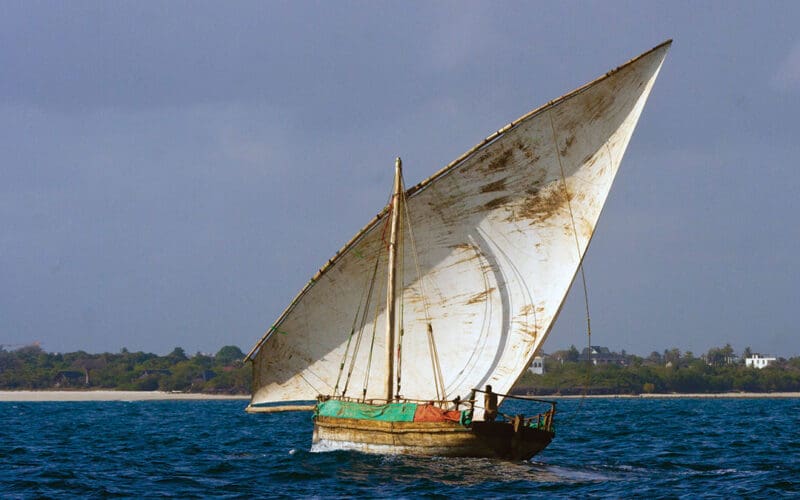
Tanzania, if people are aware of it at all, evokes images of safaris on the vast African plains or perhaps the challenge of climbing Mt. Kilimanjaro with its famous snow-capped peak. Prior to the global pandemic, we had no plans to go there on Perry our Privilege 482 catamaran. Not only had we already visited more than a decade before, it sits in a sort of no-man’s land for global cruisers. It’s not on a direct route to the Red Sea from Asia and doesn’t beckon to south-bound Indian Ocean cruisers like Madagascar does. To make our way back to the Atlantic, we had initially decided to head to the Red Sea and the Mediterranean. When the need for new rigging delayed our departure from Malaysia, we realized we had lost our seasonal weather window and decided on the southern route via South Africa. Neither scenario had included Tanzania.

But our scenarios also hadn’t included a global pandemic and the chaos it would wreak on cruising plans. After weathering Covid-19 border closures and lockdowns in Sri Lanka and finally making our way through the Maldives, Chagos and then spending several months in the Seychelles, we reached a critical decision point. With our visas coming up for very expensive renewal, we needed to go somewhere. Madagascar’s borders were still closed to visitors and the season for heading to South Africa was still a couple of months off. It only seemed logical to head west and make the 1,000 nautical mile jaunt to Tanzania. It was one of the few countries that had never shut its doors during the pandemic, costs seemed very reasonable — especially compared to the Seychelles — and some quick research indicated both decent anchorages and the potential for some amazing adventures. Decision made!
After a spirited six-day sail, we arrived at the anchorage off Stone Town, Zanzibar. With exposure to the swells and a healthy dose of ferry and tour boat traffic, the anchorage was a bit rambunctious. But it was a welcome respite from almost a week at sea in the south Indian Ocean. Local sailing dhows elegantly and silently drifted past our stern while the scents of local cooking wafted over the boat.
Tricky beach landing
We headed to shore and timed the waves to manage our beach landing without embarrassing ourselves. The three-meter tides meant we had to drag our dinghy all the way up the steep beach. We vowed to repair our deflated dinghy wheel sooner rather than later. A number of friendly Tanzanians offered to help, but with the kids being bigger and finally able to add some muscle, our family of four had it sorted in no time. Throughout our visit, there were many offers of help with the hope of a gift or reward in exchange, especially in areas with a lot of tourists. They were good-natured and usually not too persistent.
We completed our formalities with Health and Immigration at the crowded ferry terminal, with just a few delays. Tanzania is one of those countries that doesn’t get many cruisers, so the check-in process is not always smooth for visitors like us. Case-in-point is the transire, a cryptic (and primarily commercial shipping) document reportedly required to be secured and presented at each official port of call in Tanzania. Securing the document in the various ports and determining what to do with it was confusing and different in each port — almost every official we talked to had a different interpretation on whether the transire was required or not. However, as always, a courteous and good-humored attitude went a long way towards smoothing over any of our mistakes.
Stone Town was a fascinating city, full of narrow, winding streets. On some you can stretch out both arms and touch the ancient Arab-designed buildings on either side. It’s easy to lose your way and the thick, stone buildings have a tendency to block your cell phone signal, so good luck trying to rely on Google Maps. One of our new Tanzanian friends guided us through the maze to the local “cell phone store” which ended up being a bunch of guys on the street near the local market, stocked with fanny packs jam-packed with a seemingly random assortment of (most likely) pre-owned SIM cards. Since this was where most of the locals also seemed to be getting their SIM cards, we went with the flow and, after a transaction that included three of the vendors furiously talking amongst themselves and trading cards and various vouchers, we had a working cell phone. These transactions always leave you feeling a bit uneasy as you’re never quite sure of their legality, or what kind of tourist mark-up you’re paying. But the price seemed all right and “when in Rome” and all that.
As a thank you to the “guide” who found us the SIM card dealer, we agreed to buy a package of spices from one of the ubiquitous spice stands (Zanzibar is, after all, known as the Spice Island) run by his “friend.” After negotiating down from an even more exorbitant price, the effusive thanks that our friend/guide gave us (he would certainly get a referral fee) suggested that he was pleased at the amount we had paid. We continued to wander through the outdoor market, filled with colorful fruits and vegetables and carts overflowing with fish or piled high with bread. Returning to the boat through the maze, we admired the heavy and ancient Indian-inspired Gujarati doors carved from teak and mahogany that adorned most buildings.

We spent a few days exploring Stone Town and enjoying the affordable prices. The economic contrast was stark between the Seychelles, one of the most expensive countries we have visited, and Tanzania, one of the cheapest. We sampled the street foods at the night market and found a restaurant with the most succulent barbecued Tikka chicken cooked in a huge cast iron Tandoor oven. We repaired that dinghy wheel with the help of a local engineering shop that could seemingly fix anything. No throwaway culture here. Along the beach, young men practiced impressive Brazilian-style capoeira flips. Despite some interest, we gave the Freddy Mercury museum a pass due to its highly touristy (and costly) vibe. Ultimately, Stone Town’s less-than-flat anchorage (I’m almost certain the ferry boat captains make a sport of seeing how much wake they can produce) helped us to decide to head off to Tanga, where we planned to leave the boat while we went on safari.
Time in Tanga
We hiked up our spinnaker and headed up to the northernmost point in Zanzibar, Nungwi, as an overnight stop. We anchored next to expanses of white-sand beaches and resorts. Due to light winds, time constraints and strong currents, most of our passage involved motoring or motor-sailing but it was calmer than our Stone Town anchorage. The following day, we arrived in Tanga and waited on board for Health and Immigration to clear us again. Despite being part of Tanzania, in some ways Zanzibar, and its sister island Pemba, is almost treated as a separate country. So our clearance from Zanzibar wasn’t acceptable on the mainland and we repeated the process.

Tanga is a sleepy town without many tourists. The yacht club welcomes visitors and, for a fee that we thought was reasonable, offers security, free water, reasonably priced meals, cheap and cold beer, and a clever dinghy pulley system to deal with the big tides. The kids were able to sail with the local children’s sailing club run by the yacht club.
The protected anchorage was a sheltered and safe, if somewhat muddy, place to leave the boat while we headed off on safari to the Ngorongoro Crater and Serengeti, which was an unforgettable experience for our family. Safaris in Tanzania are expensive in large part due to high park fees but the sheer number of animals seems to prove that the country is doing something right in preserving its wildlife. While the safari ate up a big chunk of our annual cruising budget, we didn’t regret it at all as it was truly a once in a lifetime experience. And already being in Tanzania meant we were able to arrange an itinerary directly with the local tour companies and avoid the mark-up that re-sellers add in. When we returned from ten days of National Geographic-esque animal immersion, Perry was still safely anchored where we left her in the care of a Brazilian girl from a cruising family we had met years before in French Polynesia, who now lives in Tanzania. It’s a small world.

It was now time to start heading south to position ourselves for our November weather window to cross to South Africa. This is a passage not to be taken lightly and we wanted to make sure we weren’t running late. We were sad not to have time to explore the many anchorages and excellent diving around Tanzania’s other large island, Pemba. We made a few day hops down the coast, visiting Dar es Salaam — the big city — for a couple days. The Slipway boatyard and hotel charged a small daily fee for a tender to shuttle boaters back and forth between their boats and shore. Due to the tides, there is no secure place to leave your own tender on shore. Dar es Salaam offers the contrast of modern buildings and paved roads next to shacks and dirt roads. We spent an entire day waiting in line to see an ophthalmologist (was it just age or the bumpy roads of the Serengeti that caused a problem? We’ll never know) listening very carefully so as not to miss our “next-in-line” number being called out in Swahili. It does pay to learn a few words of the local language.
Working south
After leaving Dar es Salaam, we stopped at tiny Koma Island, where Mohammed gave us a tour of the island and introduced us to the children he teaches. He is primarily a fisherman, but holds classes for pre-school aged kids to give them a head start before they start primary school at the government-run facility. We helped out his efforts by donating some of the school materials that our kids had outgrown.
We stopped at Mafia Island, known for whale sharks. We had already been lucky enough to swim with whale sharks in Indonesia, so we weren’t too disappointed that we weren’t able to find any. We saw several tour boats darting around, depositing snorkelers and then picking them back up a minute or two later to keep chasing the sharks. Continuing south, we played the constantly varying winds and currents to arrive in Kilwa Masoko. We toured the fascinating ancient ruins of nearby Kilwa Kisawani, a Unesco World Heritage site and marveled at what was left of a once-mighty economic powerhouse.
We made our way down to be close to Mtwara, the southernmost port in Tanzania, to check out of the country. A much nicer, nearby anchorage is in Mikindani Harbour, about five miles away from Mtwara. Here we enjoyed the laid-back vibe of the “yacht club,” friendly locals and baobob trees that rimmed the very sheltered bay within a bay. Emmanuel, the owner of the yacht club, also manages the nearby historic Boma Hotel. The hotel is owned by a charity that runs a number of programs to improve the lives of local residents, providing training in various areas.
While in Mtwara, we were also lucky enough to meet the owners of a local cashew nut factory, who took us on a tour of the facility. The factory makes a point to employ primarily women, who otherwise have few job prospects in Tanzania. It’s hard work with many labor-intensive steps in the process. The nuts must be shelled by hand and the shells contain potent allergens and acids. The women are constantly dipping their hands in oil to help keep the irritants from getting to their skin. We certainly never appreciated all the work that goes into this “simple” snack food.
When a decent looking weather window opened up to make our way down the Mozambique channel to Richards Bay, South Africa, we completed our final provisioning, bought some additional jugs of diesel, and checked out of the country. Tanzania definitely stands out in our nearly 10 years of cruising for its unique natural beauty and warm people. While we arrived by happenstance, we’d certainly recommend cruisers consider Tanzania as a worthwhile destination. n
Matt and Jennifer TenEick and their sons Conrad and Mark voyaged aboard their 1992 Privilege 482 catamaran, Perry. For more on their Tanzania trip and their voyages go to their blog www.svperry.com.

